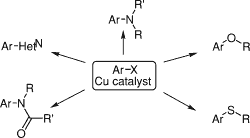(Chief Bee)
12-08-03 08:14
No 475380
(Rated as: excellent)
This article might shed some light on the bromovanillin alkoxylation and other similar reactions...
Renaissance of Ullmann and Goldberg Reactions – Progress in Copper Catalyzed C–N-, C–O- and C–S-Coupling
Klaus Kunz, Ulrich Scholz, Dirk Ganzer
Synlett No. 15, pp 2428–2439 (2003) (../rhodium/pdf /ullmann.gold
DOI:10.1055/s-2003-42473

Abstract:
Copper-catalyzed C–N-, C–O- and C–S-coupling reactions are powerful tools in organic synthesis and have been extensively reinvestigated in the past five years. The understanding of solubilizing and accelerating effects exhibited by substrates and ligands initiated novel developments originally on N-arylation of amines, amides, and nitrogen heterocycles. Nevertheless practical methods for the syntheses of aryl ethers and aryl thioethers have been established as well. A wide range of arylating reagents was explored, of which the aryl halides will be presented in this overview. Among a growing set of ligands and optimized reaction protocols, the most promising procedures are highlighted, covering the literature published through May 2003.
(Chief Bee)
09-06-04 15:03
No 529885
(Rated as: excellent)
Review:
Modern Synthetic Methods for Copper-Mediated C(aryl)O, C(aryl)N, and C(aryl)S Bond Formation
Steven V. Ley, Andrew W. Thomas
Angew. Chem. Int. Ed., 42(44), 5400-5449 (2003) (../rhodium/pdf /cu-mediated.

Abstract
The copper-mediated C(aryl)N, C(aryl)O, and C(aryl)S bond formation is an important transformation and has been developed to include a wide range of substrates. This Review highlights the recent developments in the copper-mediated (both stoichiometric and catalytic) reactions of aryl boronic acids, aryl halides, iodonium salts, siloxanes, stannanes, plumbanes, bismuthates, and trifluoroborate salts as aryl donors. In particular, the recent introduction of boronic acids as reaction partners in both O- and N-arylation has been a significant discovery and will occupy centre-stage in this review. Clear improvements can be obtained by the correct choice of copper source, base, ligands, and other additives. Mechanistic investigations should provide insight into the catalytically active species, which would aid in the development of milder, more-efficient methods.
The Hive - Clandestine Chemists Without Borders